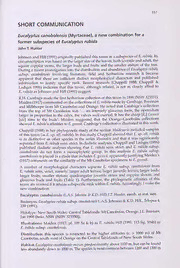
Eucalyptus canobolensis (Myrtaceae), a new combination for a former subspecies of Eucalyptus rubida PDF
Preview Eucalyptus canobolensis (Myrtaceae), a new combination for a former subspecies of Eucalyptus rubida
157 SHORT COMMUNICATION Eucalyptus canobolensis (Myrtaceae), a new combination for a former subspecies of Eucalyptus rubida John T. Hunter Johnson and Hill (1991) originally published this taxon as a subspecies of E. rubida. Its circumscription was based on the larger size of the leaves, both juvenile and adult, the square coppice stems, the larger buds and fruits and the smaller stature of the tree. During a recent investigation into the distribution and abundance of Eucalyptus rubida subsp. canobolensis involving literature, field and herbarium research it became apparent that there are sufficient distinct morphological characters and published information to justify specific rank. Recent research (Chappill 1988; Chappill & Ladiges 1996) indicates that this taxon, although related, is not as closely allied to E. riibida as Johnson and Hill (1991) suggest. R.H. Cambage made the first herbarium collection of this taxon in 1899 (NSW 325551). Maiden (1917) commented on the collections of E. rubida made by Cambage, Boorman and Millthorpe from Mt Canobolas and Orange. He noted that Cambage's collection from the top of Mt Canobolas was '... an intensely glaucous form, the operculum larger in proportion to the calyx, the valves well exerted. It has the sharp [E.] Gunnii [sic] rims to the buds'. Maiden suggested that the Orange-Canobolas collections showed E. rubida's affinities to E. gunnii. Cambage's collection is illustrated in this work. Chappill (1988) in her phylogenetic study of the section Maidenaria included samples of this taxon (as E. sp. aff. rubida). In this study, Chappill showed that E. sp. aff. rubida is as distinctive as other species in the series Viminales and that it was significantly separated from E. rubida sens, strict, in cladistic analyses. Chappill and Ladiges (1996) published cladistic analyses showing that E. rubida sens, strict, and E. rubida subsp. canobolensis do not form a monophyletic group. In this analysis E. rubida subsp. canobolensis is placed in a clade that includes E. gunnii, apparently justifying Maiden s (1917) comments on the similarity of the Mt Canobolas specimens to E. gunnii. A number of morphological characters separate E. rubida subsp. canobolensis from E. rubida sens, strict, namely: larger adult leaves; larger juvenile leaves; larger buds; larger fruits; smaller stature; quadrangular juvenile stems and coppice shoots; and glaucous buds and fruits (Table 1). Furthermore, the phylogenetic affinities of this taxon are masked if it retains subspecific rank within E. rubida. Accordingly, I make the new combination: Eucalyptus canobolensis (L.A.S. Johnson & K.D. Hill) J.T. Hunter, comb, et stat. nov. Basionym: Eucalyptus rubida subsp. canobolensis L.A.S. Johnson & K.D. Hill., Telopea 4: 239 (1991). Holotype: New South Wales: Central Tablelands: Mt Canobolas, Orange, J.L. Boorman, Jan 1908 (holo: NSW [NSW 325550]). Illustrations: Maiden (1917: pi. 109 5a & b) as E. rubida; Hill (1991: 113 fig. 104b) as E. rubida subsp. canobolensis. Distribution: this species is restricted to the higher altitudes (c. > 1000 m) of Mt Canobolas, south west of Orange on the Central Tablelands of New South Wales. Habitat: Eucalyptus canobolensis occurs predominantly above 1100 m, but can be found less abundantly down to 1000 m. The species is most common between 1200 and 1300 m 158 Telopea 8(1): 1998 altitude. Above 1300 m E. pnuciflora becomes more prominent. Basalt occurs over most of Mt Canobolas with many acid volcanic trachytic outcrops. The taxon occurs in sub- alpine woodland and is associated with E. pnuciflora, E. dalrympleana, E. viniinalis and E. dives as an overstorey and Poa sieberiana, Cassinia arcuata, Acaena ovina, Hydrocotyle algida and Scutellaria humilis in the understorey. Conservation status: Johnson and Hill (1991) allocated a ROTAP code (Briggs & Leigh 1996) of 2VC- for this taxon. This species was subsequently listed on the Threatened Species Conservation Act (NSW Government TSC Act 1995) as vulnerable (Schedule 2). Hunter (1998) has established that although the species is restricted to Mt Canobolas, there are probably over 60 000 individuals. Briggs and Leigh (1996) suggest that 1000 individuals in a reserve is adequate for conservation purposes. This species dominates most areas within the Mt Canobolas State Recreation Area and the evidence indicates that this species is not vulnerable. A more appropriate ROTAP code is 2RCa and removal from the TSC Act is warranted. Table 1. Comparison of selected characters for Eucalyptus rubida sens, strict, and E. canobolensis. Eucalyptus rubida Eucalyptus canobolensis Plant height to 40 m 8-12 m tall (rarely to 18 m) Adult leaf length 3- 14 cm (6.5-) 10-18 cm Adult leaf width 0.8-2.4 cm 1.5-3.5 cm Juvenile leaf length 4- 5 cm (4-) 5-10 cm Juvenile leaf width 2.5-5 (-6) cm (4-) 5-10 cm Juvenile stems Round Quadangular Bud length 4-7 mm 5-9 mm Bud width 2-4 mm 3-5 mm Fruit length 4- 6 mm 5- 9 mm Fruit width 5- 7 mm 6- 8 mm Buds and fruits glaucous Sometimes Always References BnggS' J-D. & Leigh, J.H. (1996) Rare or Threatened Australian Plants, revised edition. (CSIRO and the Australian Nature Conservation Agency: Canberra). Chappill, J.A. (1988) A Systematic Study o/Eucalyptus L'Her it. informal Subgenus Symphyomyrtus Section Maidenaria (Myrtaceae). Unpublished PhD thesis. University of Melbourne. Chappill, J.A. & Ladiges, P.Y. (1996) Phylogenetic analysis of Eucalyptus informal subgenus Symphyomyrtus section Maidenaria. Austral. Syst. Bot. 9: 71-93. Hill, K.D. (1991) Eucalyptus. Pp. 76-142 in Harden, G.J. (ed.) Flora of New South Wales, vol. 2. (New South Wales University Press: Sydney). Hunter, J.T. (1998) Threatened Endemic Eucalypts of the Central Tablelands. Unpublished report for the Western Zone New South Wales National Parks and Wildlife Service (Dubbo). Johnson, L.A.S. & Hill, K.D. (1991) Systematic studies in the eucalypts-3 New taxa and combinations in Eucalyptus (Myrtaceae). Telopea 4: 223-267. Maiden, J .H. (1917) A Critical Revision of the Genus Eucalyptus, vol. III. (Government Printer: Sydney). John T. Hunter 149 Kentucky St Arrnidale, NSW 2350 Australia Manuscript received 30 June 1998 Manuscript accepted 2 October 1998
